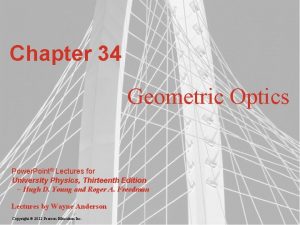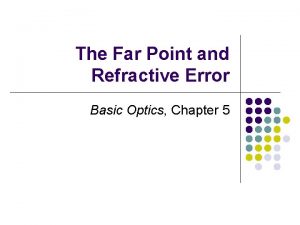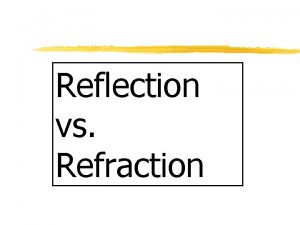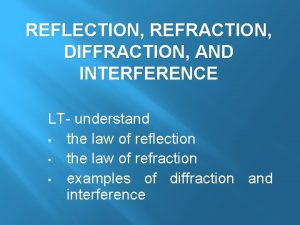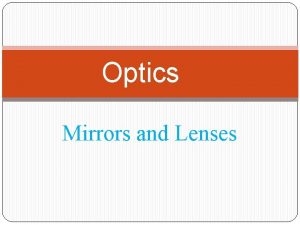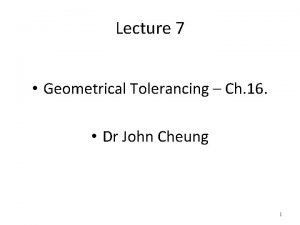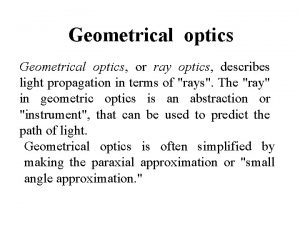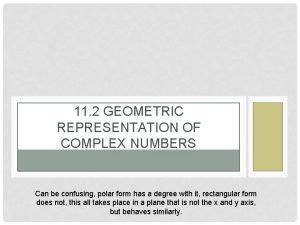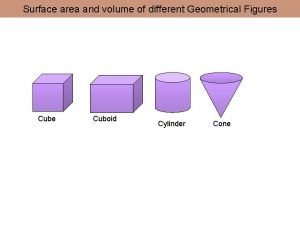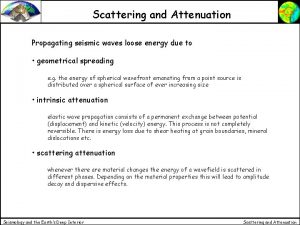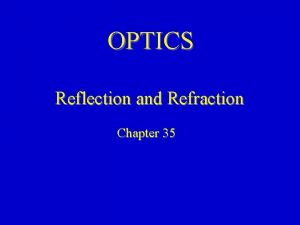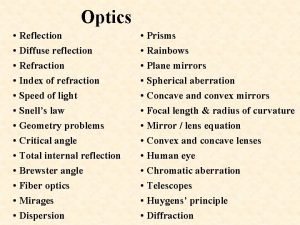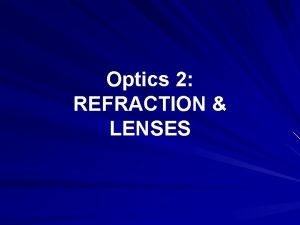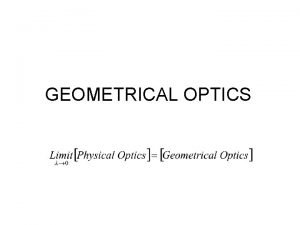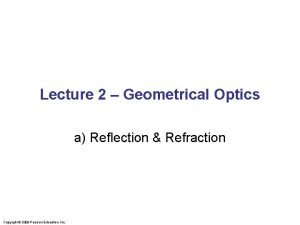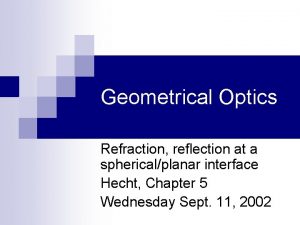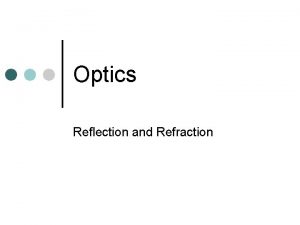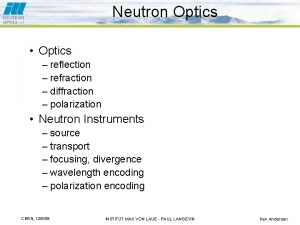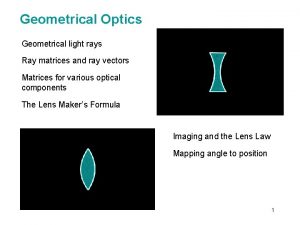So far Geometrical Optics Reflection and refraction from







































- Slides: 39

So far • Geometrical Optics – – Reflection and refraction from planar and spherical interfaces Imaging condition in the paraxial approximation Apertures & stops Aberrations (violations of the imaging condition due to terms of order higher than paraxial or due to dispersion) • Limits of validity of geometrical optics: features of interest are much bigger than the wavelength λ – Problem: point objects/images are smaller than λ!!! – So light focusing at a single point is an artifact of our approximations – To understand light behavior at scales ~ λ we need to take into account the wave nature of light.

Step #1 towards wave optics: electro-dynamics • Electromagnetic fields (definitions and properties) in vacuo • Electromagnetic fields in matter • Maxwell’s equations – Integral form – Differential form – Energy flux and the Poyntingvector • The electromagnetic wave equation

Electric and magnetic forces

Note the units…

Electric and magnetic fields

Gauss Law: electric fields

Gauss Law: magnetic fields

Faraday’s Law: electromotive force

Ampere’s Law: magnetic induction

Maxwell’s equations (in vacuo)

Electric fields in dielectric media atom under electric field: • charge neutrality is preserved • spatial distribution of chargesbecomes assymetric Spatially variant polarization induces localcharge imbalances (bound charges)

Electric displacement Gauss Law: Electric displacement field: Linear, isotropic polarizability:

General cases of polarization Linear, isotropic polarizability: Linear, anisotropic polarizability: Nonlinear, isotropic polarizability:

Constitutive relationships E: electric field D: electric displacement B: magnetic induction H: magnetic field polarization magnetization

Maxwell’s equations (in matter)

Maxwell’s equations wave equation (in linear, anisotropic, non-magnetic matter, no free charges/currents) matter spatially and temporally invariant electromagnetic wave equation

Maxwell’s equations wave equation (in linear, anisotropic, non-magnetic matter, no free charges/currents)

Light velocity and refractive index cvacuum: speed of light in vacuum 0 n: index of refraction c≡cvacuum/n: speed of light in medium of refr. index n

Simplified (1 D, scalar) wave equation • E is a scalar quantity (e. g. the component Ey of an electric field E) • the geometry is symmetric in x, y⇒the x, yderivatives are zero

Special case: harmonic solution

Complex representation of waves angular frequency wave-number complex representation complex amplitude or " phasor"

Time reversal

Superposition

What is the solution to the wave equation? • In general: the solution is an (arbitrary) superposition of propagating waves • Usually, we have to impose – initial conditions (as in any differential equation) – boundary condition (as in most partial differential equations) Example: initial value problem

What is the solution to the wave equation? • In general: the solution is an (arbitrary) superposition of propagating waves • Usually, we have to impose – initial conditions (as in any differential equation) – boundary condition (as in most partial differential equations) • Boundary conditions: we will not deal much with them in this class, but it is worth noting that physically they explain interesting phenomena such as waveguiding from the wave point of view (we saw already one explanation as TIR).

Elementary waves: plane, spherical

The EM vector wave equation

Harmonic solution in 3 D: plane wave

Plane wave propagating

Complex representation of 3 D waves complex representation complex amplitude or " phasor" " Wavefront"

Plane wave

Plane wave (Cartesian coordinate vector) solves wave equation iff

Plane wave " wavefront": (Cartesian coordinate vector) constant phase condition : wave - front is a plane

Plane wave propagating

Plane wave propagating

Spherical wave equation of wavefront “point” source exponential notation Outgoing rays paraxial approximation

Spherical wave spherical wavefronts exact parabolic wavefronts paraxial approximation/ /Gaussian beams

The role of lenses

The role of lenses
 Geometric optics ppt
Geometric optics ppt What is optics
What is optics Difference between ray optics and wave optics
Difference between ray optics and wave optics Reflection and refraction venn diagram
Reflection and refraction venn diagram Far point of hyperopic eye
Far point of hyperopic eye Rainbow total internal reflection
Rainbow total internal reflection Refraction of sound
Refraction of sound Poem reaction
Poem reaction Partial reflection and refraction examples
Partial reflection and refraction examples Reflection refraction transmission and absorption of light
Reflection refraction transmission and absorption of light Infrared light is also known as bill nye
Infrared light is also known as bill nye Reflection about invictus
Reflection about invictus Why can we represent light rays using a ruler
Why can we represent light rays using a ruler Single ray
Single ray Venn diagram of heat and electricity
Venn diagram of heat and electricity Bill nye reflection and refraction
Bill nye reflection and refraction Reflection and refraction learning task 1
Reflection and refraction learning task 1 Refraction vs reflection
Refraction vs reflection Reflection refraction diffraction interference
Reflection refraction diffraction interference Reflection refraction diffraction
Reflection refraction diffraction When a wave strikes an object and bounces off
When a wave strikes an object and bounces off Reflection refraction
Reflection refraction For lives that slyly turn
For lives that slyly turn What plots the map of the slum children
What plots the map of the slum children In a kingdom far far away
In a kingdom far far away Far far away city
Far far away city Geometric symbol
Geometric symbol Meniscus lens ray diagram
Meniscus lens ray diagram Geometrical isomers
Geometrical isomers Geometrical tolerance
Geometrical tolerance 14 gd&t symbols
14 gd&t symbols Geometrical
Geometrical Geographical data types
Geographical data types Geometrical representation of complex number
Geometrical representation of complex number Curved surface area of a cylinder
Curved surface area of a cylinder Geometrical spreading
Geometrical spreading Geometrical shadow
Geometrical shadow Geometrical isomerism
Geometrical isomerism Physics 241
Physics 241 Fibre optics disadvantages
Fibre optics disadvantages
